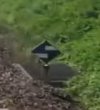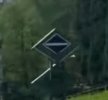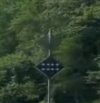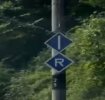For recuperation to be useful there must be another train in the same section of overhead lines which can make use of this energy, so it wouldn't make much sense to return power while still within the system switch area (which is not connected with the overhead wires on either side of the border)
Not necessarily. Modern substations can be designed to send power back to the national grid.
So at this border there seems to be a very short dead section between the panto down and the panto up signs, but nothing to indicate open main circuit-breaker and close main circuit-breaker. Will those operations be performed automatically (though I couldn't see any trackside magnets for doing that), or is it part of the driver's knowledge to know that he has to do that before (and after) dropping and then raising the pantograph. (At least I think D and CZ both use the same 1950 mm panto width!) Wikipedia seems somewhat unhelpful about electrification systems meeting up with one another!
There is a neutral catenary section - or just a void, like between NL and BE, each time the voltage, or even phase, of the catenary changes. This is to avoid big damage in case a driver would forget to lower his pantograph. Without neutral section, a raised pantograph would short the two different voltages with immense damage to the power substations. With a neutral section, which is earthed, a raised pantograph will just cause the two substations to trip.
Normally the driver lowers his pantograph when the loco crosses the horizontal line board and raises it back when the vertical line board is met.
Most of the time it is just done manually by the driver. There are a few cases where it is automated : TVM300 and TVM430 have codes for that so TGVs switch automatically if the line is equipped with the suitable beacons. In Paris, at junctions between RATP and SNCF (like in the tunnel between Paris Nord and Chatelet Les Halles, RER B & D), it is automatic also, and per unit, so you can see a MU train going south with its first unit under 1,5 kV DC and the second one still under 25 kV AC.
On Belgian and French multisystem locs, there is a selector, available only when the loco is powered down, named "sélecteur d’administration" that lets the driver choose which system he is using, and will select the correct loco configuration (pantograph, power circuits, motor couplings, signaling system, etc) accordingly. When a pantograph is raised, the loco first "senses" whether the catenary voltage matches the selection made by the driver and trips the loco if not.









